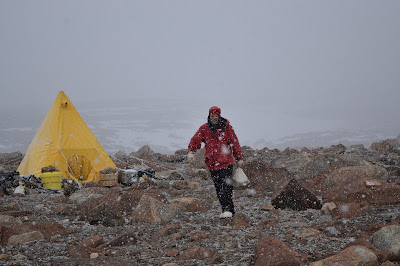Although long overdue, I have finally finished my blog about
my trip to Antarctica. It’s impossible to accurately describe the incredible things
that I experienced and the powerful lessons that I learned in the world’s
coldest, highest, driest, and windiest desert, so I have instead opted to provide
a day-by-day synopsis of my expedition with Professor David Marchant and
graduate student Andrew Christ.
In the future I will write more about particular experiences, but for now, here is the third entry in a 4 part “Month in the Life of an Antarctic Researcher” series.
In the future I will write more about particular experiences, but for now, here is the third entry in a 4 part “Month in the Life of an Antarctic Researcher” series.
12/26/2015
Another day sampling rocks for cosmogenic nuclide
dating. Many of the samples we took on this day were drilled from large
boulders, so we only sampled 8 rocks and boulders in 8.5 to 9 hours of work.
It was also
the first day I tried cabin bread and peanut butter (see Natalie and Emma’s
cookbook for details) which became a personal Antarctic lunchtime favorite! Unfortunately,
I began feeling sick later in the day, showing many of the same symptoms
Professor Marchant had shown prior to falling sick for several days including a
headache and sore throat.
 |
| An example of a drilled rock sample. This sample will later be analyzed for its abundance of cosmogenic nuclides to estimate how long it has been in its current location. Photo Credit: Andrew Christ. |
 |
| The valley, darkened by incoming low-lying snow clouds. |
12/27/2015
This was our third snow day, but was actually something of a
blessing. My headache and sore throat from the previous day were indeed the
signs of an oncoming sickness. So although it was frustrating to not be able to
do any work in our relatively short field season, I was glad to have some time
to rest and recuperate.
12/28/2015
Snow day number four… I was feeling better, but this extra
day of rest definitely helped me return to full health. The snow day was boring,
but by the end I was feeling great and looking forward to another day of work.
12/29/2015
After consecutive snow days worsened by sickness, it was
great to return to field work. We sampled 11 more rocks after a full day of
work. At dinner we discussed our plans for a future camp move. While most of
our work needed to be done in the valley at Mackay Glacier, Professor Marchant
and Drew determined that it would be helpful to sample rocks for cosmogenic
nuclide dating from a location that was known to be stable and which had
already been accurately dated. Our valley’s moraines were deposited relatively
recently (on geologic time scales). Measurements from older rocks would allow Professor Marchant and Drew to test the effectiveness of cosmogenic nuclide dating on different time
scales.
 |
| An overlook of the valley. Note the series of ridges in the middle and lower left side of the image. These are moraines deposited by a glacier which once partially filled this valley. |
12/30/2015
This was one of our longest days, working essentially
non-stop from 9am to 7pm. We gathered several samples for cosmogenic nuclide
dating and began digging pits in search of buried algae which would provide
minimum dates of deposition in those regions.
12/31/2015
The last day of work in 2015 was cut short by strong winds
and heavy snowfall. We left tents after breakfast around 9am as usual and spent
the morning and early afternoon drilling rock samples off of large boulders. But
we were forced to return around 3:30pm because of the sudden and dramatic onset
of snowfall, accompanied by low visibility.
 |
| An example of low visibility conditions outside out tent. |
 |
| Drew walking between tents in the snow. |
1/1/2016
This was the most physically burdensome day of the trip, and
one of the most exhausting days of my life. Nevertheless, it was one of my
personal favorite days of our entire expedition. The day was spent precisely measuring
the location of our 46 rock samples using high-precision GPS and then
transporting all of them back to our camp (the process I described in my 12/25/2015
entry). We carried all of our samples, averaging somewhere between 7 and 10 pounds,
from their original locations back to our camp. This meant that we spent the day walking
several miles over rocky, bouldery terrain with backpacks full of rocks. It was
very difficult and tiring, but also extremely fun and rewarding. Especially
after a few recent snow days, it felt great to be able to exercise and make get
work done.-Daniel Rybarczyk
Click here for Part 1: Preparations
Click here for Part 2: Entering the Field
Click here for Part 4: Thriving, Moving, and Leaving

No comments:
Post a Comment